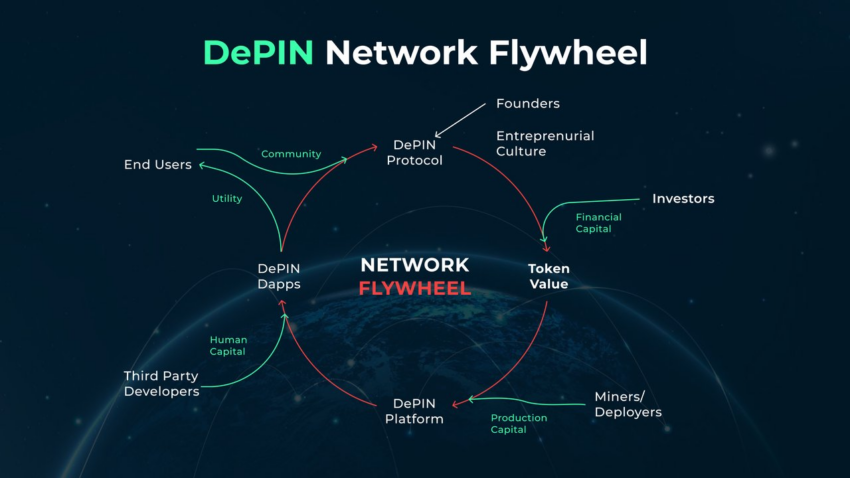Integrating blockchain technology with tangible, practice-oriented applications is becoming increasingly important. Decentralized physical infrastructure networks (DePIN) is indeed a sector experiencing exponential growth. Approximately 650 new projects were launched, catapulting DePIN’s market cap to an impressive $20 billion and generating an estimated $15 million in on-chain revenue annually.
The growing interest in DePIN reflects its potential to revolutionize traditional systems by democratizing access to essential services and promoting community-driven solutions.
DePIN’s promise to disrupt monopolies
DePIN is at the forefront of combining the decentralized ethos of cryptocurrency with the infrastructure needs of the physical world. From Wi-Fi and transportation to data storage and energy, DePIN provides the foundation for blockchain’s transparency, efficiency, and security to expand into the real world. This shift aims to increase the usefulness of blockchain and provide users with tangible benefits and rewards.
It is worth noting that this sector is currently controlled by three of the largest and most renowned technology companies in the world: Microsoft, Google and Amazon. Consequently, forging partnerships, developing business and generating organic demand in this crypto space could be more challenging than others. Therefore, its success largely depends on the continued trend of increasing censorship by Big Tech.
Yet crypto infrastructure is expected to grow exponentially in regions where governments are intensifying restrictions on dissent and imposing stricter controls on freedom of expression. This scenario presents significant opportunities for serving gray market customers.
“DePIN will be one of the most important areas of crypto investment in the coming decade. Storage solutions, decentralized wireless networks and other hardware networks are critical to the long-term viability of the industry. They could also disrupt an absolutely gigantic set of monopolies. Legacy cloud infrastructure is a $5 trillion global market cap sector,” Messari analysts wrote.
DePIN’s appeal lies in its promise to decentralize wealth and control associated with infrastructure development. It expands the capabilities of the Internet of Things (IoT) by integrating blockchain and community-driven incentives. Essentially, DePIN bundles the necessary compute and storage capabilities from different sources, making them immediately available to developers and their applications.
Shann Holmberg, Chief Operating Officer at Lunar Strategy, told BeInCrypto that such a framework promises to reduce operational costs, scale efficiently and provide a robust alternative to traditional infrastructure models.
“Decentralizing resources enables the widespread adoption of innovative technologies, even in remote or underdeveloped areas. This global reach enables users from all corners of the world to participate in and benefit from decentralized technologies, fostering a more inclusive digital environment,” said Holmberg.

How DePIN works. Source: IoTeX
This approach is gaining popularity among crypto investors who see it as a scalable solution to global infrastructure challenges. DePIN aims to transform public infrastructure into a more inclusive, efficient and participatory system by using blockchain.
The impact of DePIN on Web3 is great. It offers a decentralized model that removes bottlenecks and promotes a more reliable platform for decentralized applications (dApps). By improving resource availability and global accessibility, DePIN catalyzes the widespread adoption of innovative technologies, especially in underserved regions.
“DePIN transforms traditional infrastructure systems by decentralizing and shifting control from large corporations to a community of individual contributors. Similar to miners in a Proof-of-Work network, each participant contributes resources and has a say in the system in proportion to their investment,” said Holmberg.
Top DePIN projects to keep an eye on
Developing effective incentive models, navigating the extensive development, and competing with established Web2 giants can be challenging. Still, the potential benefits of community control, fair pricing, and incentives make a compelling case for the transformative power of DePIN.
“Things like file storage, wireless access and cloud computing require a lot of capital expenditure and operational headaches, and making a hardware network viable is a non-trivial challenge. Tokens have proven effective in catalyzing the development of these networks because they coordinate decentralized hardware investments at scale,” Messari analysts pointed out.
DePIN projects such as Rowan Energy are pioneering sustainable practices. It uses blockchain for the production and consumption of clean energy in the energy sector. This innovative approach supports the global drive for net-zero emissions and encourages the adoption of renewable energy through mechanisms such as NFT Carbon Offset Certificates.
The wireless sector is also witnessing a revolution with projects such as Helium Network. It aims to disrupt traditional connectivity models by rewarding providers with cryptocurrency. This model illustrates how DePIN can provide fair connectivity solutions, marking a significant shift from centralized providers.
“Helium Network challenges the dominance of major network providers. With a smart multi-token system, each token plays a crucial role in managing network resources and compensating providers. Users burn the HNT token to access connectivity services, and the MOBILE token is the lifeblood of Helium’s 5G project,” Holmberg explains.

Top DePIN projects. Source: Messari
Meanwhile, decentralized storage networks like Filecoin are redefining data storage and cloud computing. By providing secure, efficient and affordable storage solutions, these projects highlight DePIN’s potential to challenge and potentially surpass traditional cloud services.
“An AI cannot learn without data. If the data is compromised due to a single point of failure, or if the central data storage entity changes its access rights or prices, any AI dependent on that storage entity will cease to exist. It is an existential risk and that is why I argue that AIs should use a decentralized storage solution,” said Arthur Hayes, co-founder of BitMEX.
Despite challenges, DePIN projects signal a robust movement towards more democratic, efficient and sustainable infrastructure solutions. This transformative journey is about technological advancements and reimagining the fundamental systems that support the digital and physical world.
Disclaimer
All information on our website is published in good faith and for general information purposes only. Any action the reader takes based on the information on our website is strictly at your own risk.

